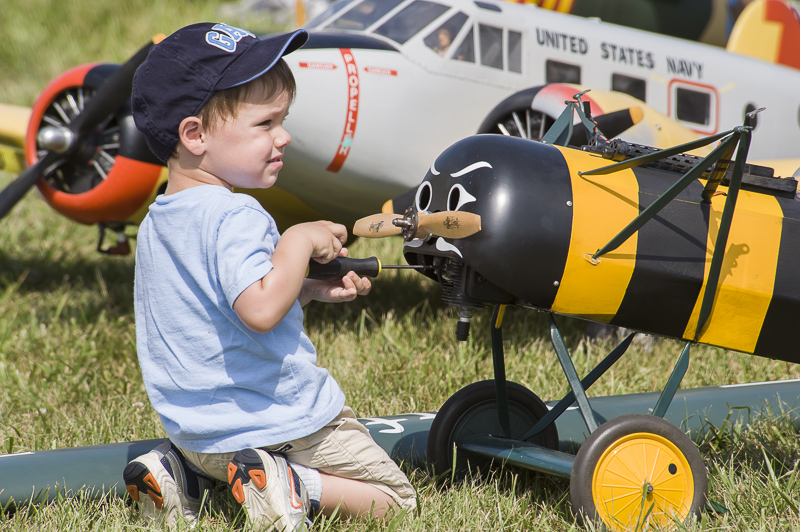Many modelers ask me how I got interested in building and flying large airplanes. They ask for advice and information on how to go from .40 to .60 size planes using glow engines to giant models using larger gas powered models. I won’t put this into a step-by-step dissertation, but rather discuss some of the things modelers should consider when contemplating such a move. Some of this information is nothing more than good old common sense, supported by my own personal experiences and a few tips and tricks thrown in for good measure. There are usually a number of ways of accomplishing any desired goal, so none of my advice should be considered the one and only way. I’m merely presenting and sharing what works well for me.
 First we have to decide what type of large model we want. This decision is based on several factors. How much time and money are we willing to invest? Is our work area, storage area and transportation vehicle large enough? Do we have sufficient building and flying experience? A modeler who has successfully built and flown a high wing trainer, a low wing sport plane and maybe a fun-fly plane, will probably have the necessary experience to build and fly an high or low wing sport or semi-scale giant project.
First we have to decide what type of large model we want. This decision is based on several factors. How much time and money are we willing to invest? Is our work area, storage area and transportation vehicle large enough? Do we have sufficient building and flying experience? A modeler who has successfully built and flown a high wing trainer, a low wing sport plane and maybe a fun-fly plane, will probably have the necessary experience to build and fly an high or low wing sport or semi-scale giant project.
You might have notices that I didn’t recommend a high-performance aerobatic model such as a CAP, or Ultimate biplane, or a heavy metal warbird like a P-51 Mustang. I believe a modeler’s first giant should be similar to his first trainer or sport plane, just bigger and heavier. Before we can run, we first have to walk, so I suggest starting out with one of the many gentle giants that are a lot of fun to fly.
When choosing that first giant, I suggest taking a few survey trips to some of your local flying fields, and visit with some of the modelers who fly gas powered giants. Ask for their opinions on gas-powered giant, and consider not only the models they recommend, but their reasoning as well. Add all this to your own preferences, like …”What kind of planes do I like? What color should it be? Should it be high or low wing? Maybe a biplane? Take your time, consider all the advice you’re given, and don’t overestimate your capabilities. It’ll be a decision you’ll have to live with, hopefully for a long time to come.
Once we choose a model, we then have to select a suitable engine for it. If our dream machine is large enough, I suggest using a gasoline power plant rather than glow fuel. Gas engines seem to last forever, they’re usually easier to start and they run on relatively inexpensive fuel (Who but R/C modelers considers gasoline to be relatively cheap?)
On the negative side, gas engines are usually heavier than glow engines, some require an additional battery for the electronic ignition system, they produce less power than similar displacement glow, and there’s a nasty rumor going around that they cause radio interference.
Our first engine decision should be what size to use. I usually follow the recommendations of the kit designer when it comes to power, except when no gas engine size is given. In that case, I make the choice based on the engine’s weight, physical size and power. To me, power is how fast it turns a similar size propeller being driven by a glow engine. Notice I did not mention the word “Horsepower”. Any engines advertised horsepower is basically useless information when it comes to determining the true power of that engine. Advertised horsepower is usually based on manufacturer’s claims, which often results from testing done with unrealistic propellers turning unrealistic engine speeds. One particular engine that I like a great deal is advertised as producing 3 horsepower at 16,000 RPM. In reality, there’s no way that engine can turn 16,000 RPM unless it is turning a 6” diameter propeller! That 3 horsepower rating is simply ridiculous. Basically speaking, advertised horsepower should not ever be considered when choosing an engine for a new project. Besides, how many airplane designs have you seen that recommend using a certain horsepower engine? Engine recommendations are almost always based on an engine’s internal capacity, cubic inches or cubic centimeters.
The weight of an engine is another critical consideration. Remember, it’s hung out there at the very front end, where it plays an important role in determining the position of the airplane’s center of gravity (CG) If you decide on building a model with a short nose, like a WW1 fighter, You’ll need a lot of nose weight to help balance the model properly. Your gas engine just may provide some or all of the required nose weight to do just that.
On the other hand, using gas engines with longer nose moments sometimes makes them nose heavy. If your models wasn’t designed to use a gas engine, you may want to reconsider using one and stick to a glow engine.
OK, let’s assume that we’ve now chosen our new giant airplane and a proper size gas engine. Now, how are we going to mount it to the firewall? Some of the smaller gas engines can use traditional beam mounts, but most use some sort of backplate mount. Engines with side mounted mufflers and carburetors typically use some sort of sheet metal or cast metal backplate that can require the use of stand-offs or a spacer box to position the engine far enough ahead of the firewall to clear the fuselage sides or cowl. Aircraft plywood can be used, but that gets heavy. Custom metal stand-off posts are available from numerous manufacturers, and they’re available in a large number of lengths and diameters to suit the installation. I have sometimes used ¾” hardwood dowels drilled for mounting bolts to pass through and cut to the proper length. Large diameter fender washers are used to spread the load where the dowels (or metal stand-offs) where they contact the firewall. I seldom if ever use blind nuts to install gas engines. I have experiences many cases where they pull through the firewall or have stripped their threads when tightened too much. I prefer to use through-bolts, at least 10-32 in size, with fender washers and safety nuts (also called elastic stop nuts) behind the firewall. These are sometimes hard to install, but they’re a lot safer to use.
Engines using rear mounted carburetors or mufflers (or both) may require the firewall to be cut for clearance, with the resulting opening into the fuselage needing to be capped off, usually with plywood. Be sure to keep the muffler at least ¼” away from any wooden parts.
Many modern gas engines have rear mounted carburetors. This makes for a nice, narrow engine profile, but it often complicates engine mounting. In these cases, the best solution is to cut a hole in the firewall for the carb to pass through, mounting the engine to the remaining firewall using stand-offs, and cap the carb area opening form the inner fuselage. Remember to provide the carburetor with plenty of fresh air.
If you’re thinking that the firewall will be weakened by a large carburetor clearance hole, fear not. A securely mounted engine actually strengthens the firewall, since the metal engine case and mounts is far stronger than the firewall itself. Another thing to keep in mind is the choice of using soft mounts, sometimes called vibration isolating mounts. All reciprocating engines produce vibrations, and single cylinder engines produce more than multi-cylinder types. Engine vibration is probably the number one cause of structural failure. Trying to isolate this vibration is difficult at best, and the use of soft mounts can actually decrease the amount of power transmitted to the propeller. Since the airframe is always larger and heavier than the engine, it’s able to absorb a lot more vibration if properly constructed. The best thing to do is minimize the vibration by carefully balancing propellers and use hard mounts.
So far we’ve chosen a new giant model, selected a suitable power plant and determined how to join the two together. In future installments we’ll talk about possible modifications to both kit built models and almost-ready-to-fly (ARF) models. I’ll mention things that may prove necessary by adding reinforcements, using the proper adhesives, achieving the correct balance and more. I hope you have learned something useful in this installment, and will put it to good use when you make the giant leap from smaller planes to giants.
Thanks for listening and see y’all next time.

